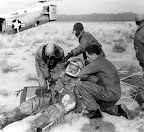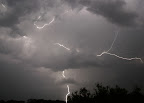 Military investigators have poured blood, sweat, tears and taxpayer dollars to a variety of strange experiments. There are many reasons that they are willing to take take a chance on anything.
Military investigators have poured blood, sweat, tears and taxpayer dollars to a variety of strange experiments. There are many reasons that they are willing to take take a chance on anything.Some people may feel that we need to invest in risky projects to maintain the edge over our enemies. Other people may see projects that are not common as a way to raise money for their own personal crusade.
Alaska Area 51
The facility is known as HARRP, or high frequency active auroral research program, and is intended to answer some interesting questions about the ionosphere. But it has raised more questions among conspiracy theorists. Over the years, been called a weather control machine, and machine
superweapon spy most underground. As if to create an artificial aurora borealis is not weird enough.
 BATBOMB
BATBOMBToward the end of World War II, the Air Force was looking for better ways to burn Japanese cities to the ground. A dental surgeon contacted the White House, and suggested strapping a small incendiary device to bat, load them into cages shaped like bombshells and drop them over vast areas.
According to the plan, millions of bats will flee from bombshells when they parachuted to earth, and flying mammals will find their way into the attic of the barn and factories, where they will rest until they bring demand to explode. In the early 1940s, tests by several armed bats leave a mess, and they set fire to a small Air Force base in Carlsbad, New Mexico.

After the accident, the project was handed over to the Navy, which continued for more than a year. During that time, the Marines do proof of concept success at Dugway Proving Grounds in Utah, where they released the bat during the mock-up of a Japanese city. The creatures were able to get quite fires.
Nuke Test few

When a nuclear warhead detonates, you do not want to be anywhere nearby. And you definitely do not want to cover just a few miles. But during the Cold War, some soldiers are ready to begin the fight against nuclear weapons, up-close and personal, using portable launchers and low-yield bombs.
In 1960, the Army has more than two thousand nuclear weapons meant to launch small, each with a maximum range of only 2.5 kilometers. Soldiers lit firecrackers in one of the Nevada desert during the summer of 1962, while Attorney General Robert F. Kennedy watched. Exploding only 1.7 miles from where it was launched, and on the ground last-nuclear explosion conducted by the United States.
 Goo Guns
Goo GunsSquirting jihadists with sticky foam might seem like a silly plan, but the Army did not explore the option of using weapons of goo on enemy combatants, if only briefly. Since then, the government has awarded contracts for the adherents Technologies, a materials-research firm. the company aims to develop a polymer adhesive that can stop vehicles in their tracks, without harming the occupants.
As the nature of war changes, supporting combat urban and regional conflicts rather than conventional combat, the military get a lot of interest in less-lethal weapons. This is honestly interested in keeping civilian casualties to a minimum, for practical reasons. Every time innocent killed, the rebels fire Stokes and looked terrible at home.
Many units are equipped with dazzlers, a very bright laser pointer that can be used instead of warning shots, or as a means to blind the enemy. And some have long-term acoustic device, a sound cannon that can be used to issue a verbal warning, or deafen anyone who stood in the street.
Extreme Skydiving
 In 1960, Captain Joe Kittinger balloon ride up into the stratosphere - 20 miles above the earth - and then jumped out of there. He threw to the ground at 714 miles per hour, faster than the speed of sound, and landed safely on the sand in the desert of New Mexico.
In 1960, Captain Joe Kittinger balloon ride up into the stratosphere - 20 miles above the earth - and then jumped out of there. He threw to the ground at 714 miles per hour, faster than the speed of sound, and landed safely on the sand in the desert of New Mexico.daring leap is part of Project Excelsior, an attempt to explore issues of safety that pilots will face when dealing with high-flying aircraft. Kittinger experimental tests proved that the parachute, designed by Francis Beaupre, will continue under the most extreme conditions.
For now, there is nothing Kittinger's record-breaking heights. But a privately funded team, supported by the makers of Red Bull, is trying to do it.
 Deadly Dolphins
Deadly DolphinsIn early 1990, a Russian military officer suspected of some of the dolphins were trained to attack enemy ships. He did experiments to show that they could recognize different boats with their propeller sounds. In theory, the mammal can be used to bring explosives into enemy ships, while leaving the friendly boat were injured.
Years later, when he was unable to care for the animals, he sold them to Iran. Their fate is still unlearned. And rumors persist even program-military wild dolphins - marine mammal swimmers are taught to kill enemy
Light Weapons
 Testing of the Active Denial System, ray gun shoots a painful millimeter wave, has ranged from the ridiculous scary. The Air Force released a report that carefully censored in 2007, after a pilot who was burned by the beam incredible strong. He played a role as a scout enemy during exercises intended to evaluate the weapon, and gets destroyed at full power for four seconds.
Testing of the Active Denial System, ray gun shoots a painful millimeter wave, has ranged from the ridiculous scary. The Air Force released a report that carefully censored in 2007, after a pilot who was burned by the beam incredible strong. He played a role as a scout enemy during exercises intended to evaluate the weapon, and gets destroyed at full power for four seconds.In a demonstration for journalists (including himself Danger Room's Sharon Weinberger), the Zapper has the opposite effect. It was raining, and even warmth.
 SWAT Team Psychic, Sorta
SWAT Team Psychic, SortaTerrorists disguised as plumbers which General James Dozier was kidnapped from his home in Verona, Italy, in 1981 and held hostage in a secret location. During the first days of the situation, the Italian government would not agree to cooperate with the investigation or rescue efforts.
Desperate to find Dozier, the military switched to psychology who works as a part of the program Flame Grill, psychology experiment where a strict evaluated and then asked to gather reliable intelligence information.
One psychic claimed that the public held in a brick building with red roof, and others suspect that the hostage was being held in Padua, a small town in the north. Days later, Dozier was rescued by a SWAT team of Italy, after a tipster led them to his location.
Dozens of academic scientists and private contractors, perform a more scientific experiments. Boeing researchers asked volunteers in 1960 to control the random-number generator with the power of the mind. Volunteers will try to control the outcome with any supernatural force they can bring to bear the problem.
And according to documents written by researchers, it works, sometimes. But not too consistent.
 Acid Guinea Pig
Acid Guinea PigThe CIA collects enough LSD During the Cold War to supply any jam band concerts in the world for a dozen generations. A variety of defense and intelligence acid test against soldiers and civilians, and some researchers decided to try it for yourself.
In his memoirs, the Army psychiatrist James Ketchum tells of a colleague who uses himself as a guinea pig. researcher was hanging around underwear with a concave piece of glass embedded in his arm. Under the glass was a mixture of LSD and ethylene glycol. He wanted to know if the formula can penetrate the skin psychedelic, and casually said that it did not work.
In another story, much darker, a researcher at the Army may have been hit after the LSD experiment chaotic. While attending the retreat in the outdoors, sipping a glass of Cointreau Frank Olson, who mixed with LSD, and had a terrible reaction. He threatened to resign.
And days later, investigators suspected biological weapons hurl myself through the 10th floor of a hotel window in New York. CIA representative said that he had become suddenly depressed. But when his body was dug up, and inspected years later, it looks like his head had been destroyed before the fall.
 Ride The Lightning
Ride The LightningLate last year, DARPA launched a lightning cannon that can hit the enemy with a blast bomb electricity crackled. After a series of scandals, the company changed its name to Applied energetics, and decided to package the re-questioning of technology as a means of crippling or destroying the vehicle improvised explosive devices.
But the prototype has a range of only 15 meters, which is too close for comfort when you try to stop a bomber detonated a car or mine. Another company, Xtreme Alternative Defense Systems, aims to revolutionize the battle with the "flash technology is directed-tuned." Namely, when the chief Pete Bitar XADS not working on flying cars.
 Raccoon Vision
Raccoon VisionNavy researchers are trying to develop a pill that would allow troops to see in the dark, or at least make out a flash of infrared that can be used to send secret messages.
Some animals have pigment in their eyes that allow them to see their wavelength, which is longer than visible light. But humans do not normally produce retinal molecules.
To give the ferret's vision of volunteers, the researchers fed them chemically similar to vitamin A, in the hope that it will turn into night vision pigments.
0 comments:
Post a Comment